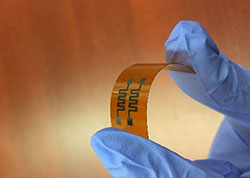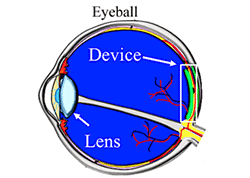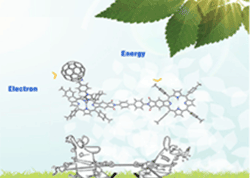Energy Harvesting, Storage and Lighting
This is a grand challenge area where research directions include developing efficient renewable energy devices, understanding light-matter interactions in nanoscale materials to enhance transduction from optical to electrical and/or thermal modalities; developing environmentally friendly materials for energy harnessing, storage and lighting for increased sustainability; smart textiles and buildings, LEDs, low-power, low-cost lighting solutions; high-efficiency, lightweight batteries; catalysis for energy storage. Also included here will be more applied and system-level research for the integration of solar cells composed of nanomaterials for energy and power systems.
Light-matter Interactions, Solar Cells and Energy Harvesting
In the area of solar cells, work being conducted by PTI-Director, Prof. Kaul and her research group, the Nanomaterials and Devices Laboratory, involves looking at materials such as black phosphorus, 2D perovskites derived from methyl ammonium and butyl amine to form attractive, stable platforms for solar cell architectures, whose physical structures are shown below. Some of these materials also require carefully controlled ambients during processing, such as in a glove-box environment, where the materials are also often dispersed on flexible substrates, as shown below.
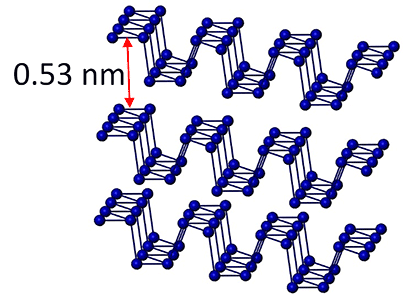
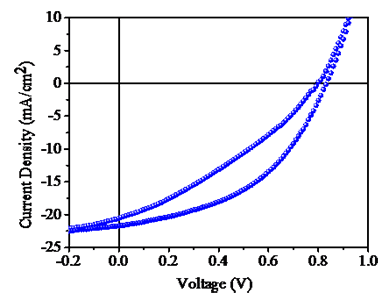
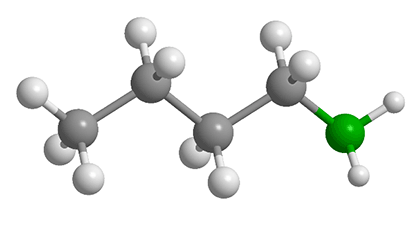
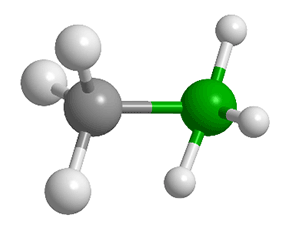
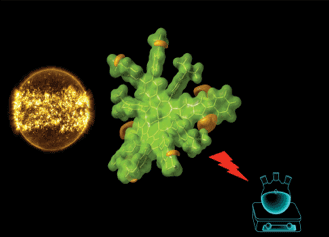 In PACCAR-affiliated faculty, Prof. Hong Wang’s Lab, a number of organic materials are being explored for understanding their light-matter interactions, where such materials also have an impact on solar cells and organic electronics. For example, b-Functionalized A2B2 push-pull tetrabenzoporphyrins were made available for the first time. The new synthetic approach developed in Prof. Wang’s group opens a door to access a number of b-functionalized tetrabenzoporphyrins, which have broad applications ranging from biomedicine to organic electronics.
In PACCAR-affiliated faculty, Prof. Hong Wang’s Lab, a number of organic materials are being explored for understanding their light-matter interactions, where such materials also have an impact on solar cells and organic electronics. For example, b-Functionalized A2B2 push-pull tetrabenzoporphyrins were made available for the first time. The new synthetic approach developed in Prof. Wang’s group opens a door to access a number of b-functionalized tetrabenzoporphyrins, which have broad applications ranging from biomedicine to organic electronics.
Reference:
S. Kumar, X. Jiang, W. Shan, R. G. W. Jinadasa, K. M. Kadish, and H. Wang, “β-Functionalized trans-A2B2 push–pull tetrabenzoporphyrins,” Chem. Commun. 54, 5303-5306 (2018). Highlighted in back Cover page.
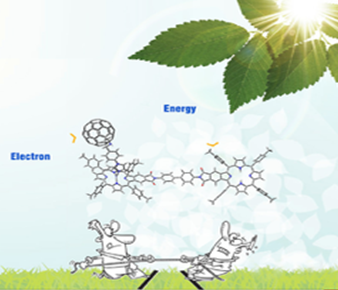 PACCAR-affiliated faculty Prof. Wang and her research group is also exploring the light-matter interactions and electron transfer in supramolecular triads. This study provides a step forward to unraveling the complex photochemical events occurring in natural photosynthesis.
PACCAR-affiliated faculty Prof. Wang and her research group is also exploring the light-matter interactions and electron transfer in supramolecular triads. This study provides a step forward to unraveling the complex photochemical events occurring in natural photosynthesis.
Reference:
Y. Hu, M. B. Thomas, R. G. W. Jinadasa, H. Wang, and F. D’Souza, “Competitive Energy and Electron Transfer in β‐Functionalized Free‐Base Porphyrin–Zinc Porphyrin Dimer Axially Coordinated to C60: Synthesis, Supramolecular Formation and Excited‐State Processes,” Chem. Eur. J. 23, 12805-12814 (2017). Highlighted in Cover Page.
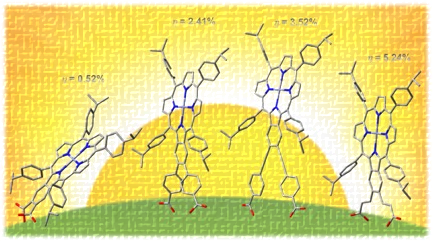 In Prof. Wang’s Research Lab, a significant linker effect was observed in benzoporphyrins. These linkers provide the possibility to stabilize dye-sensitized solar cells.
In Prof. Wang’s Research Lab, a significant linker effect was observed in benzoporphyrins. These linkers provide the possibility to stabilize dye-sensitized solar cells.
Reference:
R. G. W. Jinadasa, B. Li, B. Schmitz, S. Kumar, Y. Hu, L. Kerr and H. Wang, "Monobenzoporphyrins as Sensitizers for Dye-Sensitized Solar Cells: Observation of Significant Spacer Group Effect," ChemSusChem 9, 2239 – 2249 (2016). DOI:10.1002/cssc.201600619.
Additionally, pentacene was made stable through fusion with porphyrins. The exceptional stability of pentacenoporphyrins represents new opportunities in semiconducting materials and in singlet fissions.
Reference:
L. Jiang, J. T. Engle, R. A. Zaenglein, A. Matus, C. J. Ziegler, H. Wang, M. J. Stillman, “Pentacene-Fused Diporphyrins”, Chem. Eur. J. 20, 1-7 (2014). Selected as a “hot paper”. DOI: 10.1002/chem.20140459.
In PACCAR-affiliated Faculty Prof. Yuankun Lin’s research lab, The Photonic Band-gap Materials Lab, organic light emitting diodes are being explored. Shown in (a) below is the simulated light extraction efficiency for the organic light emitting diode integrated with graded photonic super-crystals. In (b) the computed E-field intensity distribution in the organic light emitting diode can be seen. Those newly discovered graded photonic super-crystals can be used to achieve a high light extraction efficiency up to 76 % (interestingly, the US Department of Energy has a goal of reaching an extraction efficiency of 70% by 2020).
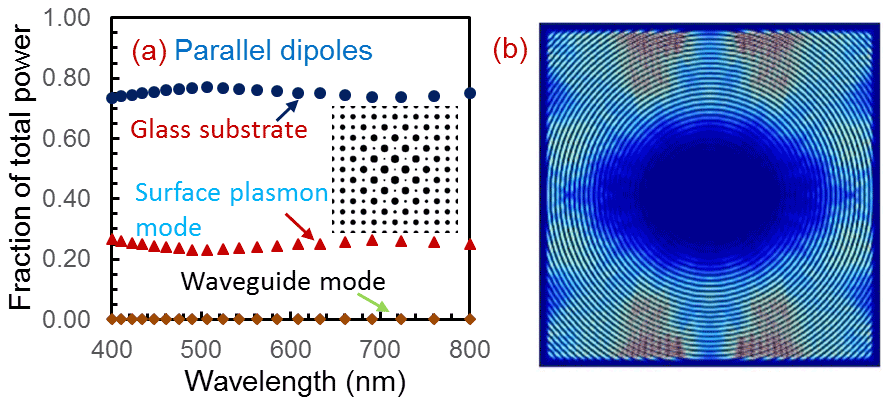
References:
S. Hassan, D. Lowell and Y. Lin, “High light extraction efficiency into glass substrate in organic light-emitting diodes by patterning the cathode in graded superlattice with dual periodicity and dual basis,” J. Appl. Phys. 121, 233104 (2017)
S. Hassan, O. Sale, D. Lowell, N. Hurley, and Y. Lin, “Holographic Fabrication and Optical Property of Graded Photonic Super-Crystals with a Rectangular Unit Super-Cell,” Photonics 5, 34 (2018)
D. Lowell, S. Hassan, O. Sale, M. Adewole, N. Hurley, U. Philipose, B. Chen, and Y. Lin, “Holographic fabrication of graded photonic super-quasi-crystals with multiple-level gradients,” Applied Optics 57, 6598 (2018).
Prof. Yuankun Lin’s lab is also developing perfect light absorbers. Shown in (a) is a unit super-cell of graded photonic super-crystal with dual basis and dual period. In (b) the simulated broad band total light absorption is shown in the graded photonic super-crystal device. Total light absorption in broad wavelength is desired for applications such as solar energy harvesting and sensor.
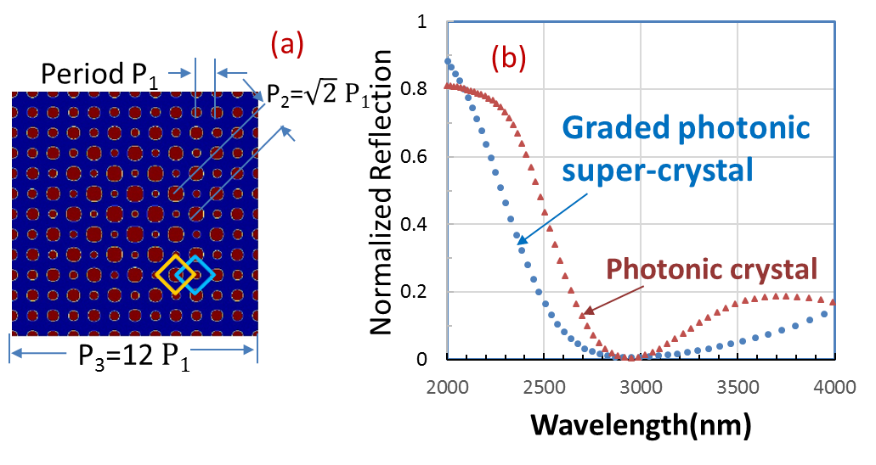
References:
M. Adewole, D. Lowell, S. Hassan, D. George, H. Zhang, J. Cui and Y. Lin, “Broadband Plasmonic Total Light Absorption in an Al-doped ZnO/spacer/silver Stack Patterned with Graded Photonic Super-crystal,” Res. J. Opt. Photonics 1, 11000101 (2017).
S. Hassan, D. Lowell, M. Adewole, D. George, H. Zhang, and Y. Lin, “Extraordinary Light-Trapping Enhancement in Silicon Solar Cell Patterned with Graded Photonic Super-Crystals,” Photonics 4, 50 (2017).
Faculty Affiliated with Focus Area 3
Anupama Kaul
Yuankun Lin
Hong Wang
Please note, some of the faculty listed above also have overlap activities under Focus Area 1.





